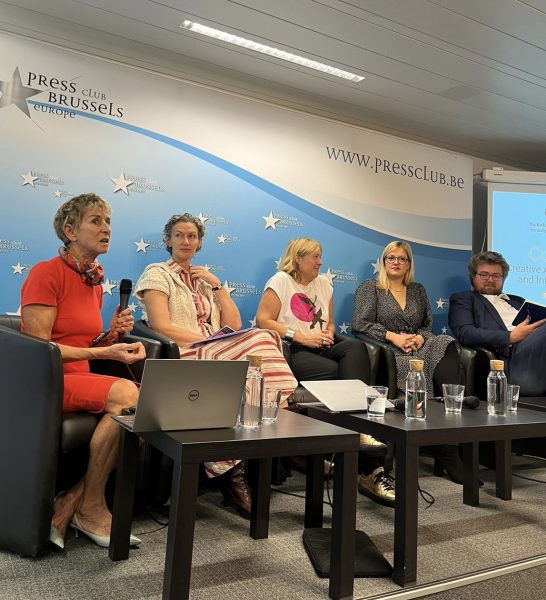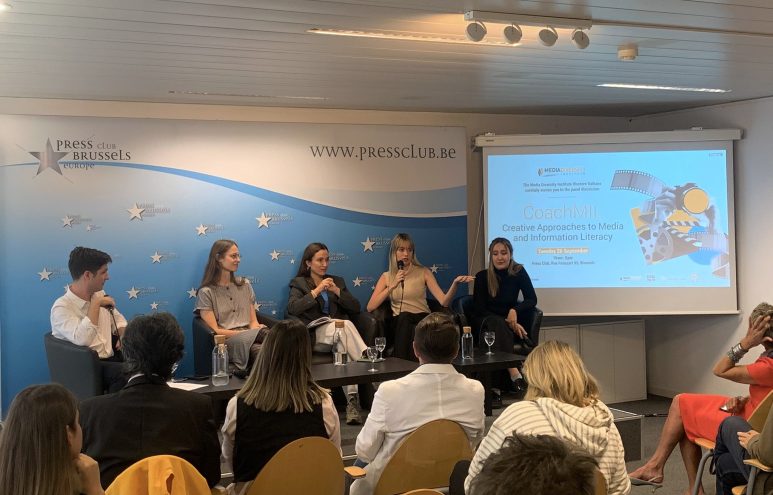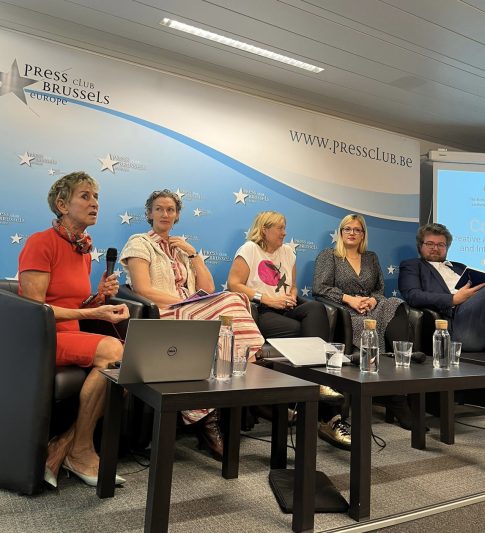New alternative and creative approaches to developing media and information literacy, especially aimed at young people, were presented, and examined during a panel discussion at the Press Club in Brussels.
This event was organised by the Media Diversity Institute Western Balkans in collaboration with Albanian Media Institute and Fade In, as part of the Scale Up Media Coach (CoachMIL) project, which aims to increase the media literacy competencies of primarily young people in three project countries – Albania, Croatia, and Serbia, but also to bring European experiences and good practices into the three countries that are on the bottom end of European MIL (Media and Information Literacy) index.
Media experts, journalists, influencers and film makers from the Western Balkans and other parts of Europe came together to exchange their expertise and examples of good practice from their specific regions.

Guido di Fiore, Head of the Business Sector at Creative Europe, held the opening remarks where he stressed the importance of media literacy for the future of European policy and announced a budget increase in this sphere. He also stated that it is important to focus on youth when it comes to developing MIL, saying:
“It’s like swimming, if you learn to swim at 40 years old, it would be very difficult, because you will be scared of the water, what’s behind it, the sharks… it’s the same for media literacy.”
In the first panel, “Youth and media consumption”, moderated by Milica Pesic, Executive Director of the Media Diversity Institute, media experts and journalists discussed the different youth-friendly approaches to improving media and information literacy. All panellists agreed that children and youth are not a homogenous group and that different age groups require different approaches, for example, 10-year-olds are not consuming the same content in the same way as 16-year-olds.
Sonja Merljak Zdovc, editor-in-chief of the Slovenian children’s magazine Časoris talked about creating content for kids and creative approaches they use in workshops for teachers and students when teaching MIL.

Janette Ballard, media literacy consultant, discussed one of the pioneer MIL programmes in British schools which she was a part of as a journalist working at the BBC. “We were teaching kids to ask questions”, she highlighted, explaining that as young children we ask a lot of questions, but as we get older, we ask fewer and fewer.
Camille Pollie from VRT, Flemish public service broadcaster, mentioned similar courses and tools they created for teachers to use with students when teaching and developing MIL and content such as children’s news that are streamed on television but used in classrooms as well. She pointed out that “young keeps getting younger” as children start using social media at a younger age ever and spend most of their time on platforms like YouTube and TikTok. Pollie stressed that there is no way to know exactly what your audience wants, but what media can do is to explore what works well with your audience.
Andy Demeulenaere from Mediawijs, the Knowledge Base for Digital and Media Literacy of the Flemish government in Belgium, also stressed the importance of looking at children and youth as a diverse group and presented the many differences between different age groups, addressing the importance of media adapting to these specifics.
Marina Zec, journalist at Oblakoder, a youth portal from Serbia, stressed that financial issues are a big problem in Serbia when attempting to provide quality media content for youth. However, she believes young people are interested in this type of content, even articles and texts, as this is the main content Oblakoder produces. Despite the ever-shorter attention spam, Zec encouraged the panel and guests by saying that over 50% of the Oblakoder audiences comes from on the website directly, so obviously in search of their rather long-form content.
Following this, the second panel explored Creative Approaches to Media and Information literacy. Milan Inic, content creator from Serbia, moderated this panel and opened the discussion by sharing the findings of the most recent Research on the needs and existing practices in the field of MIL in Albania, Croatia, and Serbia, conducted as a part of the CoachMIL project. The results showed that there is a lack of government support to MIL in formal and informal education, however international donors and civil society organisations play a pivotal role in filling that gap.
Milica Lee Filipovski shared her experiences as a young film director and talked about the mainstream film scene in the Balkans aimed at a very young audience and often promoting harmful narratives. She also stressed the importance of taking a critical approach when beginning to direct a new film and thinking through how the audience will perceive the content presented to them.
Moreover, Nikolina Pavicevic, content creator and author of Kriticki, an online platform promoting critical thinking and gender equality, and Iva Paradjanin, founder of the podcast Tampon Zona (Buffer Zone) on gender equality and women’s rights shared their experiences of creating new alternative online platforms for younger audiences.
Pavicevic said she uses ongoing real-life examples when creating content and directly interacts with her audience, which provides her with instant feedback, which she is able to do as she produces content for social media, which is a platform that allows this.
Podcasts are a good platform for long conversations as it allows us to multitask while listening, said Paradjanin. She emphasised that this format is great for telling stories about social justice and activism, as “you have space to give a voice and give a megaphone to people who are often ignored, invisible and marginalised”.
Kelly Hrupa, Media and Information Literacy Coordinator at SALTO PI, encouraged educators, and anyone interested in MIL to use the numerous sources SALTO PI offers. Hrupa also said it is important to use a more holistic approach when teaching MIL. “The best way to approach MIL is to tie it with these other narratives, to make a fuller picture of what it all means, because life does not happen in a compartmentalised way, everything is mixed, everything is integrated.”
All panellists emphasised the importance of interacting with your audiences, a practice where traditional media is way beyond media content producers that use their social media platforms to voice their opinion.

